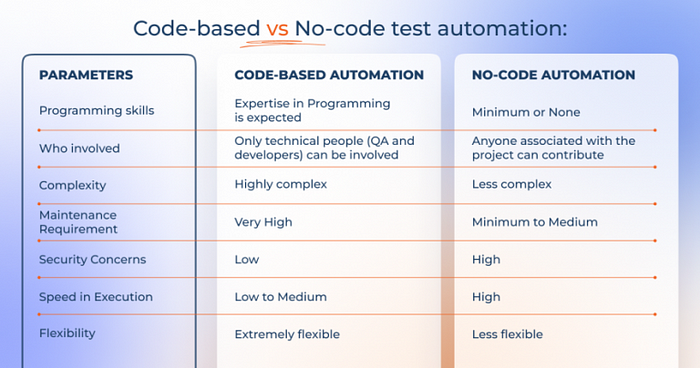
The world is entering a new era. A new era of quick fixes, simplifications and turnkey solutions. One of such ready-made implementations became the no-code solutions.
No-code/Low-code tools are already becoming a mainstay for many global commands. With no code/minimum code, teams can now fill the gap between growing application delivery requirements and team skill sets. While these instruments are on their way to becoming mainstream in development, similar test automation tools are making their way into the market.
By 2027, the global market for low-code platforms is projected to reach approximately US$65 billion, according to Statista.
However, a new problem arises: such decisions are not flexible and often do not cover even the minimum needs for testing. But why does this happen? Let’s find out in our article.
What is No-code Test Automation?
At first glance, codeless automated testing, or no-code automation, makes it possible to create automated tests without writing a single line of code. It sounds especially tempting for beginners that special skills and abilities supposedly are not needed to automate the execution of such test code.
Where did the Hype for No-code Come From?
The no-code trend emerged as software development teams began measuring the ROI of their work and looking for ways to improve it.
A few years ago, creating automated tests was a complex and chaotic task for most, with teams trying to develop their internal structures by merging multiple open-source libraries.
In some cases, these costly and laborious efforts have not been successful. These projects often became increasingly challenging to maintain.
Why did Most No-code Test Automation Projects Fail?
Despite the seemingly universal decision, most of these projects fail. Why?
The main reason is a lack of planning. The temptation to build an in-house test automation solution from scratch by bundling open-source libraries is too strong. And a lot of questions remain:
How long will it take?
How much will it cost us?
Will the investment pay off?
At this stage, no one asks, “Are we reinventing the wheel?” Because they are afraid to hear a positive answer.
Many are tempted by the zero cost of an open source library like Selenium. However, it’s worth knowing that the time you spend writing code for these tests still results in a considerable cost for your company.
Most of these in-house test automation implementations would be projects created and maintained by just 1–2 developers. And as a result, such projects are abandoned.

There is No Such Thing as Codeless Automation.
There are a lot of similar no-code implementations on the market today. They are actively advertised and promise to solve all problems.
Many “solution” vendors advertise their products as “codeless,” meaning everyone on the team can create, run, and maintain automated tests without writing code. However, this is only partially true.
It’s not without code. It is a hidden code.
In fact, these tools are not codeless at all. The triggering test is really just hidden. There are no monkeys in the situation that magically follow the instructions to make up the test. As a user of such an instrument, you are still writing code (that is, writing instructions so that a machine can interpret them), only with a different syntax. It’s not without code.
No-code expands the possibilities, but it also has limits.
Using no-code tools has the potential to lead more people to participate in writing automated tests. The downside is that this also limits the scope of automated tests. A “no-code” solution is often just an abstraction layer on top of the test automation code. And since this is an abstraction, the details are lost. So you may lose access to the functions of the underlying code. For example, you are using a no-code abstraction on top of Selenium. In this case, you may lose access to certain wait, synchronization, or error handling mechanisms (which is what makes Selenium so powerful).
Moreover, no-code can restrict access to hooks in an application or limit you to certain types of automated tests. If such a decision makes it easier to write automated tests, for example, at the user interface level, there is a significant risk that all tests will be noted at this level, even if there may be more efficient approaches to begin with.
Does no-code help solve complex problems?
While coding may seem difficult to people who haven’t done it before, it’s not that difficult if you’ve taken a couple of introductory programming courses or courses at Codecademy. It takes work to write good, readable, maintainable code. Structuring your tests and testing the right things at the right level. Creation of reliable test data and test environment strategy. It’s hard. And test automation without code solves none of these problems.
What is the Way?
It is important to remember that no-code platforms are not designed to completely eliminate the need for traditional development skills. Basically, they are designed to ensure that any member of the team has the necessary tools for testing. And when it comes to nuances and specific cases, the no-code platform cannot meet the requirements of enterprises. The only thing that will work here is programming skills. It goes without saying that developers cannot be replaced.
In simple scenarios, no-code can work, but if you want a stable testing process that considers constant changes/additions to the product, then it is much more optimal and profitable to have standard automation.
Knowing about the problems with no-code instruments firsthand, the QATestLab team recommends using the usual automation method (programming language + Selenium), since it provides full control over the development and execution of tests. This type of automation is much more reliable and easier to maintain.
Plus, in this case, it is possible to get optimized test cases with a basic structure that makes it easy to create or update new ones. An automated quality control engineer can integrate tests into the CI pipeline or help to set it up.
In QATestLab, we have highly qualified staff that can create autotests according to your requirements. They can help set up a CI run (standalone test run or integration into your pipeline) and prepare all the necessary instructions and documentation for autotests.
Our team creates all the basic structures of autotests, and it will be easier to automate test cases in the future. We can also supplement your QA process with detailed test cases to create new autotests and update previous documentation to upgrade existing autotests.
Simple at first glance, the decision is not always the best. However, if you want your business to really run like clockwork, you should rely on proven, flexible, and reliable solutions.
